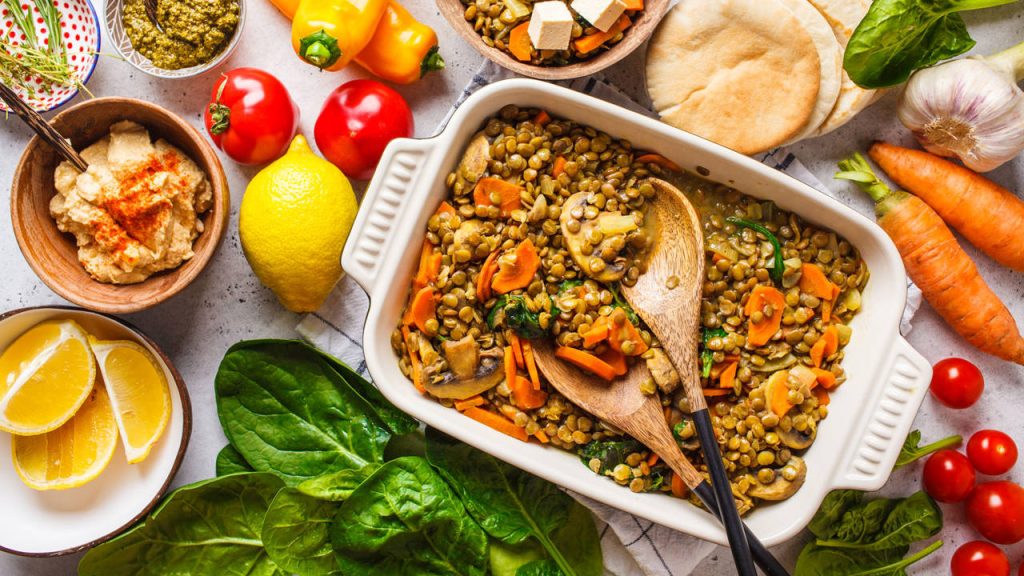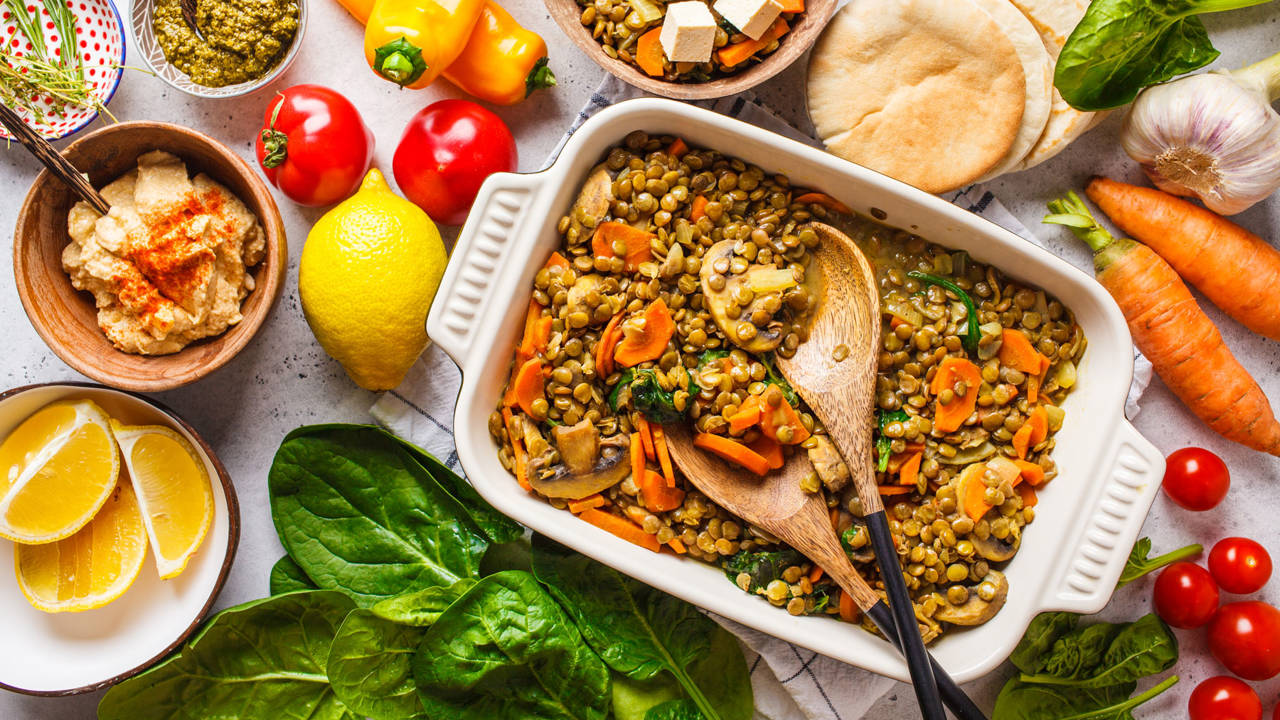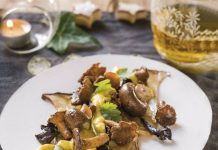Discover how to increase your iron levels by including iron-rich foods in your diet by preparing recipes in which its absorption is more effective.

- How to increase iron intake
- The Foods Richest in Iron
- How to Make Foods with a Lot of Iron
- Meals with iron to incorporate into your menus
- How do I know if I have iron deficiency or iron deficiency anemia?
Despite the fact that abundant and varied food is becoming easier to access and more information about nutrition than ever before, iron deficiency anaemia, due to iron deficiency, is among the most common health disorders, along with tooth decay or constipation. This can happen even in industrialized countries, where paradoxically there is often overfeeding.
We can make meals with a lot of iron including in them foods rich in iron well combined so that it is assimilated well. Here we tell you some tricks and give you several recipes so you can start eating a diet richer in iron.
HOW TO INCREASE IRON INTAKE
Iron is the main component of hemoglobin, the substance that gives the characteristic red color to the blood and allows cellular respiration by transporting oxygen throughout the body.
It also acts as a powerful catalyst for certain important chemical reactions carried out by enzymes and contributes to a good state of the immune system by promoting resistance to infections.
Being a trace element, iron needs are not very high: 12 mg daily in the case of man. Women of childbearing age need something more, 18 mg, due to blood loss from menstruation, especially if they are heavy.
This increased need for iron in women is even more important if she is pregnant. The requirements are also higher in the two strongest growth periods: during the first two years of life and in adolescence.
To prevent iron deficiency, it is important to know what foods are your main sources and include them in the diet.
An omnivorous diet provides two types of iron: “heme”, found in meat and other animal products, such as fish and seafood; and “non-heme” iron, provided by some vegetables, whole grains, nuts, eggs and algae.
In principle, the iron called “heme” is easier to assimilate by the body, while the “non-heme” is exposed to the action of oxalic acid, tannins and phytates, which make it difficult to use. Calcium also decreases iron absorption.
This has led to the idea that a strictly vegetarian diet can become a risk factor for iron deficiency anemia. However, as numerous studies have shown, there are plant-based foods such as algae, dried fruits or legumes, and certain supplements such as brewer’s yeast, which are powerful sources of this mineral.
Moreover, the absorption capacity of “non-heme” iron can be increased if iron-rich foods are combined with citrus fruits and other good sources of vitamin C.
Thus, it can be said that a varied and sufficiently abundant ovo-dairy-vegetarian diet perfectly covers the needs of iron and its allies, folic acid and vitamin C, to keep away the ghost of anemia.
THE FOODS RICHEST IN IRON
In addition to meat, certain vegetables, whole grains, wheat germ, legumes and nuts provide good doses of iron.
A balanced diet should provide all the iron your body needs. It is true that meat is rich in easily assimilated iron (it provides 2 to 4.7 mg of this mineral per 100 g), but it should not be abused.
Iron can be perfectly obtained from nuts (between 3 and 7 mg/1 00), legumes (between 6 and 7 mg), vegetables (between 0.3 and 4 mg), or fish (from 0 to 2.5 mg).
Other foods very rich in iron are some algae, pumpkin seeds or wheat germ. It is also important to note that it is advisable to accompany these foods with others rich in vitamin C. This also ensures that the body assimilates the mineral better.
Although algae are still poorly understood, it is worth incorporating them into the diet as generous sources of iron. Taking as a reference doses of only 20 g, the richest this mineral are sea spaghetti (11.8 mg), dulse (10 mg), nori and wakame (6 mg).
Sea spaghetti and dulse seaweed are very rich in vitamin C that facilitates their absorption.
HOW TO MAKE FOODS WITH A LOT OF IRON
Following some very simple culinary tips and tricks can increase the supply of iron and promote its absorption naturally.
- Cooking water. A good part of the iron in food is transferred to water during cooking. It is a good habit to reuse that broth for the preparation of creams or sauces.
- Utensils. The use of cast iron cookware can provide small amounts of this mineral to the diet, especially when preparing acidic recipes such as tomato sauce, which favors the dissolution of iron. Even if it is inorganic iron, the body can take advantage of it if it needs it.
- Vitamin C increases the absorption of iron, so it is highly recommended to accompany meals with a good salad or season dishes with plenty of parsley, which is rich in both vitamin C and iron.
- Vegetables. Some good sources of iron have very few calories and instead many vitamins, especially spinach and chard. Sorrel, which is taken in salads, is an exceptional source of iron.
- Kombu seaweed. Legumes, rich in iron, can be further enriched if cooked with a kombu seaweed leaf.
- Whole wheat bread. If it has been made with mother yeast, its phytic acid is broken down by phytase, so the iron is better assimilated.
- Tea or coffee. It is advisable to avoid them in meals if you suffer from anemia, because their tannins reduce the absorption capacity of iron.
MEALS WITH IRON TO INCORPORATE INTO YOUR MENUS
WATERCRESS SALAD WITH PISTACHIOS AND ORANGE WITH SESAME SAUCE
INGREDIENTS (SERVES 4):
- 75 g peeled and chopped pistachios
- 400 g watercress
- 2 medium oranges
- 1 bunch curly parsley
- 50 g radishes
- 75 g bean sprouts
- 50 g iziki seaweed
- salt
For the sauce:
- 1 tablespoon soy sauce
- 1 teaspoon sesame oil
- 1 tablespoon brown sugar
- 2 tablespoons olive oil
- 1 teaspoon Modena balsamic vinegar
PREPARATION (12′ + 30′ COOKING):
- Let the iziki seaweed soak for about 20 minutes. After that time, cook for half an hour with the same soaking water and a little salt.
- Wash the watercress, chop them and discard the thicker stems. Chop the parsley into twigs and cut the radishes into slices. Peel the oranges and separate the segments, removing the white skin.
- To prepare the sauce, pour all the ingredients into a glass jar with a lid and shake so that it is homogeneous.
- Mix the salad ingredients with the bean sprouts and drained seaweed. Pour in the sauce, stir and sprinkle with chopped pistachios.
NUTRITIONAL INFORMATION
- Iron per serving: 10.3 mg. It covers 86% of men’s daily needs and 57% of women’s.
- Calories: 284.
MILLET AND PEA TERRINE
INGREDIENTS (SERVES 4-6):
- 200 g millet
- 75 g cooked peas
- 2 onions
- 1 grated carrot
- 50 g spinach leaves
- 2 garlic
- 2 eggs and 1 yolk
- 200 ml milk
- 450 ml water or broth
- white pepper
- oil to grease the mold
- salt
For the sauce:
- a bunch of fresh parsley
- 100 ml milk
- 100 ml olive oil
- 1 garlic clove
- freshly ground white pepper
- salt
PREPARATION (15′ + 1 H. 5′ COOKING):
- Put on the fire a thick-bottomed casserole with a little olive oil. When the oil is hot, add the chopped onion along with the finely chopped garlic and sauté over medium heat for a few minutes until the onion is transparent.
- Next, add the millet and stir with a wooden spoon. Pour the water or broth, salt and pepper and cover the container with a lid that fits well. Let cook over high heat, and when it boils, lower the flame almost to the minimum and leave about 8 minutes more, until it absorbs the broth completely. Finally remove from heat and let stand, covered, for 5 minutes.
- Meanwhile, grease a rectangular baking pan with oil, and line the walls with spinach leaves.
- Beat the eggs and yolk together with the milk, and mix everything with the already cooked millet, peas and grated carrot. Pour the mixture into the mold and place in the oven, already preheated to about 180 ºC, into another somewhat larger container with two fingers of water.
- Prepare the sauce by pouring the oil and milk into the glass of an electric mixer. Let stand so that they separate and acquire the same temperature. Add the garlic clove and beat everything until the mixture emulsifies well. Then add the salt and the bunch of chopped parsley, and crush again until the sauce acquires a greenish color.
- After about 50 minutes, remove the terrine from the oven and let cool to unmold it. It is served warm, with the green sauce, some pink lollo leaves and cherry tomatoes.
NUTRITIONAL INFORMATION:
- Iron per serving: 7.2 mg. Covers 60% of men’s daily needs and 40% of women’s daily needs
- Calories: 395.
BROWN LENTIL STEW WITH SPINACH AND PINE NUTS
INGREDIENTS (SERVES 4):
- 350 g brown lentils
- 20 spinach leaves
- 1 medium onion
- 1 carrot
- 2 garlic cloves
- 1 bay leaf
- 2 tablespoons chopped parsley
- 2 tablespoons pine nuts
- 1 teaspoon sweet paprika
- 1 teaspoon lemon zest
- 2 tablespoons olive oil, salt
PREPARATION (12′ + 1 H. 10′ COOKING):
- Cover the lentils in cold water with a little salt and a bay leaf, and bring to the fire.
- When the water comes to a boil, let it cook slowly, until they are soft. Then remove from heat, drain and set aside.
- Then, in a separate pan with hot oil, fry, over low heat, the chopped onion, the carrot cut into thin sticks and also the two crushed garlic cloves.
- When the onion is golden brown and the carrot is tender, add the spinach, julienned and without the trunk. Let everything cook for 2 minutes and then add the lentils along with the chopped parsley and the zest of the lemon. Bring to a boil, with enough broth, for 3 more minutes.
- Finally, serve hot, sprinkled with a little sweet paprika and two tablespoons of pine nuts.
NUTRITIONAL INFORMATION:
- Iron per serving: 8.9 mg. It covers 74% of men’s daily needs and 49% of women’s.
- Calories: 397.
BEETROOT JULIENNE WITH ORANGE
INGREDIENTS (SERVES 4):
- 700 g raw beetroot
- 1 orange (juice and skin)
- 1 whole sheet of kombu seaweed
- 1 tablespoon sesame seeds (half white and half black)
- 1 tablespoon chopped fresh chives
- oil for frying
PREPARATION (25′ + 1 H. 45′ COOKING):
- Soak the kombu strip for at least half an hour.
- Meanwhile, prepare the beet by removing part of its leaves, but leaving some of the stem so that it retains the color well when cooked. Cover with cold water in a saucepan and bring to a boil. Lower the heat and let cook for about an hour, until tender.
- In a separate bowl cook the seaweed with the same soaking water and a little salt for 45 minutes. When the beetroot is cooked, let cool, pelt it, julienne and reserve in a saucepan.
- Drain the seaweed drains and cuts into thin strips. Fry lightly in a pan and drain again, on kitchen paper.
- Remove the white part of the orange peel and cut into thin strips. Add the skin and juice to the beetroot along with tablespoons of oil. Cover and reheat a little.
- Place the kombu seaweed on top and sprinkle with the chives and sesame.
NUTRITIONAL INFORMATION:
- Iron per serving: 2.6 mg. It covers 21% of men’s daily needs and 14% of women’s.
- Calories: 229.
FRESH DATES STUFFED WITH ALMOND AND PISTACHIO
INGREDIENTS (SERVES 4):
- 16 fresh dates
- 3 tablespoons ground almonds
- 1 tablespoon chopped pistachios
- 1 tablespoon brown sugar
- 20 g unsalted butter
For the syrup:
- 100 g brown sugar
- 1 tablespoon honey
- 50 ml lemon juice
- 150 ml water
- 1 teaspoon grated fresh ginger
PREPARATION (12′ + 5′ COOKING):
- With the help of a sharp knife make a cut in the center of each date and carefully remove the bone.
- Mix the ground almonds, chopped pistachios, brown sugar and melted unsalted butter and make a paste. If necessary, add some water to obtain the desired consistency. With this paste fill the hole of the dates.
- To prepare the syrup incorporate all the ingredients in a saucepan and cook over medium heat until they reach a slight golden but transparent color. At that time add a level teaspoon of freshly grated ginger. Finally, pour the syrup over the stuffed dates, which are refrigerated before serving.
NUTRITIONAL INFORMATION
- Iron per serving: 2.1 mg. It covers 17% of men’s daily needs and 12% of women’s.
- Calories: 395.
HOW DO I KNOW IF I HAVE IRON DEFICIENCY OR IRON DEFICIENCY ANEMIA?
Some symptoms such as muscle fatigue, lack of appetite or a pale and ojerous appearance can be the timid reflection of a lack of iron in the body that must be remedied as soon as possible.
Keep in mind that a certain anemic condition is possible even taking foods rich in iron, something that should not be surprising, because in terms of nutrition one thing is what you eat and another very different what is assimilated.
There are factors that hinder the absorption of iron, just as there are others that favor it.
Iron is a relatively abundant mineral in the body. In the body of an adult male are 3 to 4 grams of this mineral, enough to make a medium-sized nail.
However, it is considered a trace element since, thanks to the efficiency of our body recycling and storing it (mainly in the liver), it is needed in very little quantity.
This explains why its deficit takes time to manifest itself and that, therefore, good prevention is necessary.
DIFFERENT IRON NEEDS
Men and women of childbearing age need different iron intakes. Getting the necessary daily amount is not difficult.
The 12 mg of iron that man needs per day can be obtained, for example, from 60 g of lentils (4.3 mg of iron), 100 g of Swiss chard (3 mg), 50 g of hazelnuts (2 mg) and 1 egg (1.4 mg).
The ideal daily dose for a woman of childbearing age would be 18 mg of iron. This is provided by 200 g of spinach (8 mg), 60 g of millet (5.5 mg), 100 g of tuna (1.5 mg) and 60 g of wholemeal bread (1.5 mg).
During pregnancy, the recommended daily ration would amount to 30 mg to meet the needs of the fetus.








